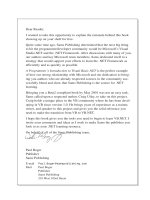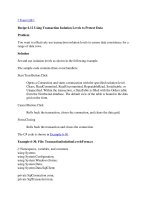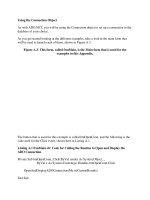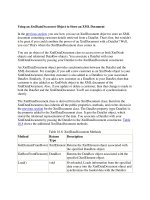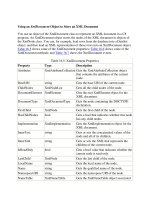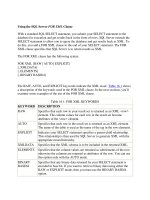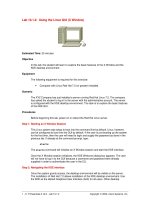Tài liệu Using the Shape Language to Retrieve Hierarchical Data doc
Bạn đang xem bản rút gọn của tài liệu. Xem và tải ngay bản đầy đủ của tài liệu tại đây (14.68 KB, 3 trang )
[ Team LiB ]
Recipe 3.14 Using the Shape Language to Retrieve Hierarchical Data
Problem
You want to use the Shape language with ADO.NET to retrieve hierarchical data from a
SQL Server.
Solution
Execute the SHAPE command as shown in the following example using the OLE DB
provider.
The sample code defines a SHAPE query to retrieve the TOP 5 Orders from Northwind
and the Order Details for each of the Orders. A DataReader based on the query is created.
The code iterates over the rows in the DataReader displaying the data for each Order row.
If the value for the column can be cast to the IDataReader interface, it is a DataReader
containing the Order Details for the Order row. The value for the column is cast to a
DataReader and the collection of records is iterated over and displayed.
The C# code is shown in Example 3-14
.
Example 3-14. File: ShapeForm.cs
// Namespaces, variables, and constants
using System;
using System.Configuration;
using System.Text;
using System.Data;
using System.Data.OleDb;
// . . .
StringBuilder result = new StringBuilder( );
// SHAPE SQL to retrieve TOP five Orders and associated Order Detail records.
String shapeText = "SHAPE {select TOP 5 * from Orders} AS Orders " +
"APPEND ({select * from [Order Details]} AS 'Order Details' " +
"RELATE OrderID TO OrderID)";
// Create the connection.
OleDbConnection conn = new OleDbConnection(
ConfigurationSettings.AppSettings["OleDb_Shape_ConnectString"]);
// Create a command and fill a DataReader with the
// SHAPE result set.
OleDbCommand cmd = new OleDbCommand(shapeText, conn);
conn.Open( );
OleDbDataReader orderDR = cmd.ExecuteReader( );
// Iterate over the collection of rows in the DataReader.
while(orderDR.Read( ))
{
result.Append("ORDER" + Environment.NewLine);
// Iterate over the collection of Order columns in the DataReader.
for(int colOrder = 0; colOrder < orderDR.FieldCount; colOrder++)
{
if (orderDR[colOrder] is IDataReader)
{
// The column is an IDataReader interface.
result.Append(Environment.NewLine);
result.Append(orderDR.GetName(colOrder).ToUpper( ) +
Environment.NewLine);
// Create a DataReader for the Order Detail from the
// IDataReader interface column.
OleDbDataReader orderDetailDR =
(OleDbDataReader)orderDR.GetValue(colOrder);
// Iterate over records in the Order Detail DataReader.
while(orderDetailDR.Read( ))
{
// Iterate over the Order Detail columns
// in the Data Reader.
for(int colOrderDetail = 0;
colOrderDetail < orderDetailDR.FieldCount;
colOrderDetail++)
{
result.Append(" " +
orderDetailDR.GetName(colOrderDetail) +
": " + orderDetailDR[colOrderDetail] +
Environment.NewLine);
}
result.Append(Environment.NewLine);
}
}
else
{
result.Append(orderDR.GetName(colOrder)+ ": " +
orderDR[colOrder] + Environment.NewLine);
}
}
result.Append(Environment.NewLine);
}
orderDR.Close( );
conn.Close( );
resultTextBox.Text = result.ToString( );
Discussion
You can retrieve hierarchical result sets or chapters (OLE DB type
DBTYPE_HCHAPTER) from SQL Server using the OLE DB .NET data provider. The
chapter is returned as a field in the data reader with a data type of Object that is a
DataReader.
Hierarchical result sets combine the results for multiple queries into a single structure.
They are generated using the Data Shaping Service for OLE DB first introduced in ADO
2.0. This provider supports the Shape language allowing the result set hierarchies to be
constructed. Shaping is an alternative to JOIN and GROUP BY syntax that you can use to
access parent/child data and associated summary data.
The connection string using data shaping is shown here:
Provider=MSDataShape;Data Provider=SQLOLEDB;Data Source=(local);
Initial Catalog=Northwind;Integrated Security=SSPI;
For more information about data shaping or the MSDataShape provider, see the MSDN
library.
[ Team LiB ]


